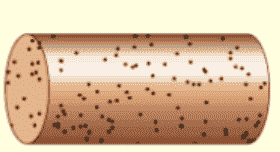Current
- Current has units of (Columbs per Second), or (Amperes)
- Current Density is the current per area
- Current measures the movement of coulombs through a wire, or a measured point on a wire.
Charge Density
- Charge density is a property of a material
- It is based of of the amount of charges per unit m3
- n = Charge Density (Given constant, property of material)
- nq = Charge per m3
- If you multiply nq by speed V, it measures the charge passing through an area per unit time (Current Density)
Resistivity
- Electrons move relatively slowly through a wire (still very fast, 2.3x10-5 m/s for a copper wire)
- They do so because as charges move through the wire, they bump into molecules and elements of the wire itself.

- E = Electric Field
- J = Current Density
- ρ = Resistivity
Resistivity ρ is a property of the material itself. It is measured in units of (Volt meters/Amps)
Examples
- Copper: ρ = 1.68x10-8 Vm/A (Not very resistive)
- Carbon: ρ = 5.00x10-4 Vm/A (Some resistance)
- Wood: ρ = 10-4 Vm/A (a lot of resistance)
Resistance
Resistance (R), unlike Resistivity is a property of the object itself. It is measured in units of (Ohms)
- R has a unit of ohms
and the big concept of resistance is
Power
Power (p) is the energy “lost” per unit time
- Power has units of {J/S} (Joules per Second) or {W}
- 60 Watts would be equivalent to 60 Joules of energy being lost per second
- Resistance creates heat, and in extreme cases, light.
- This is a dissipation of energy
- This is a consequent of work.
Work
Work is required to move a charge As speed is constant, Kinetic Energy never changes.